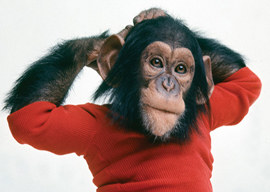
July 27, 2011

When that facility lost its funding, Nim was purchased by a medical-research lab. (America’s current chimp surplus is largely the result of their being bred lavishly to be experimental subjects in the War on AIDS.) But his fame saved him, and he was acquired by a horse shelter, where he continued to monopolize many man-hours.
It’s not exactly clear why Nim’s being raised in human luxury should privilege him over other chimps. His story is bit like Oliver Twist, in which Dickens assumes that it’s especially horrifying that little Oliver is poor because his grandfather is rich.
Maybe that doesn’t make much sense, but people do feel that way.
Remarkably, after two years of reviewing videotape, Terrace announced that he was wrong and Chomsky right. Nim’s “sentences” (none reported in Project Nim) included:
“Me banana you banana me you give.”
“You me banana me banana you give.”
“Banana me me me eat.”
In Marsh’s dopey retelling, Terrace’s scholarly heroism in publicly switching to the unpopular side is ignored. In fact, Project Nim so skimps on the science that the movie never mentions Chomsky’s name—even to explain why its protagonist is called Nim Chimpsky! Perhaps it’s not surprising that Chomsky is left out, but why ignore Goodall, who is likely the most popular scientist of the last half-century?
If Chomsky exemplifies highbrow abstraction and Goodall middlebrow information, Marsh focuses almost solely on lowbrow emotion. That would be fine, but Project Nim’s feelings are silly: ex-grad students sniping at each other over whose fault it was that Nim (like so many other adult male chimps) turned out a dumb brute.